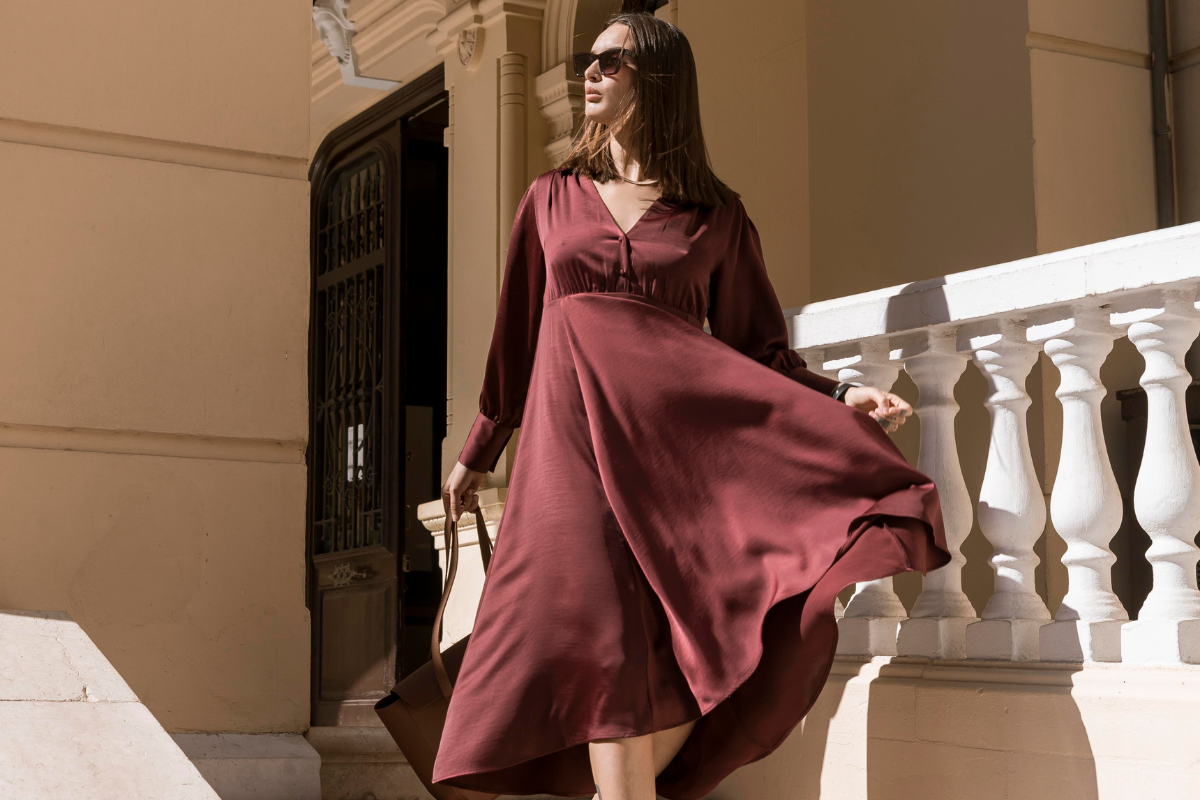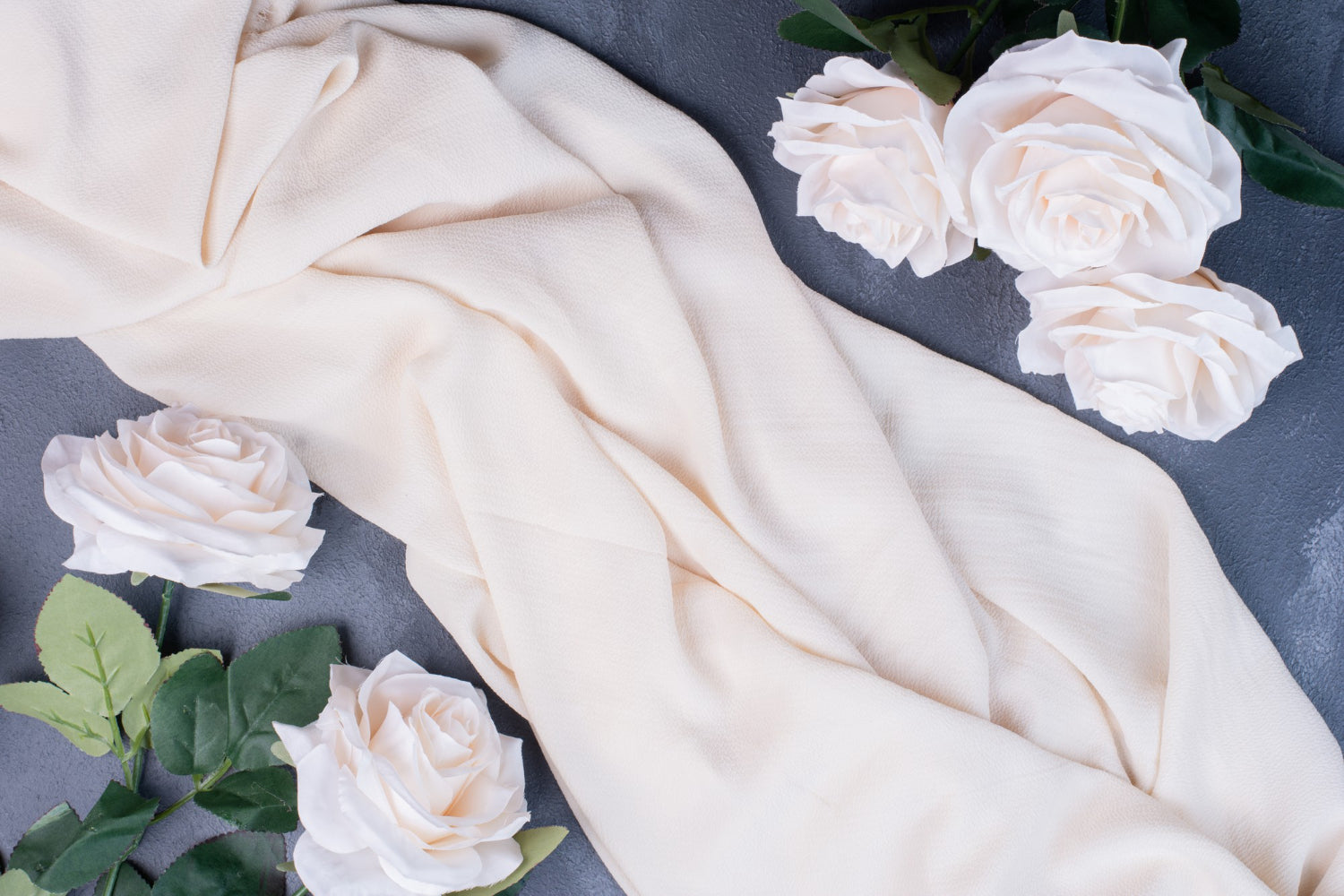Satin and chiffon are two of the most popular fabrics used in wedding gowns and bridesmaid dresses. Both have their strengths, but they create very different looks. Satin fabric is smooth, structured, and catches the light with a soft sheen. Chiffon fabric is light, sheer, and floats as you move.
The fabric you choose changes how the dress feels on your body, how it moves, and even how comfortable you’ll be throughout the day. Whether you’re the bride or part of the wedding party, knowing what each fabric offers can help you make the right choice.
What Is Satin and What Makes It So Luxurious

Understanding Satin as a Fabric
Satin is a weave construction, not a material on its own. That’s why satin fabric can be made from silk, polyester, or even blends; it all depends on how the threads are put together. Satin is woven in a way that creates a smooth, shiny top layer. Run your hand over it and you’ll feel how soft it is, with just enough weight to give the fabric some body. The sheen is what really sets it apart.
There’s more than one kind of satin. Silk satin feels rich and drapes beautifully, while light satin is easier to wear if you don’t want something heavy. Either way, satin tends to look polished and a bit more formal, which is why it shows up so often in gowns.
If you want the full story on weave, fiber content, and care, read what is satin fabric everything you need to know.
When to Wear Satin
You can spot a satin dress at almost any formal event. Think wedding gowns, satin bridesmaid dresses, prom nights, any time the look calls for clean lines and structure. Satin holds its shape and tends to stay put, which helps the dress keep that crisp silhouette. It’s also more comfortable in cooler weather since it isn’t as breathable as lighter fabrics.
If the goal is a luxurious wedding, satin fits right in. It reflects light in photos, glides across the floor, and pairs well with lace, pearls, or a bold lip. When comparing satin and chiffon, satin is the more dramatic of the two. It doesn’t float the same way chiffon does, but it gives you that classic, put-together look that never really goes out of style.
For a deeper dive into bridal styling, see why satin fabric is a top choice for bridesmaid and special occasion dresses.
What Is Chiffon and Why It’s a Bridal Favorite

Chiffon’s Airy Appeal
Chiffon is soft, light, and almost weightless. This sheer fabric is slightly see-through, with a gentle drape that moves when you do. You’ll find chiffon fabric made from all kinds of fibers, but chiffon is usually made with silk, polyester, or nylon. If it’s silk, you’re working with silk chiffon, the most delicate and luxe version.
One reason people love chiffon so much is how it moves. It doesn’t cling to the body or feel heavy. It floats with every step. That’s a big part of the allure of chiffon, especially when you’re dealing with heat or humidity. If you’re planning a summer wedding or something outdoors, it’s a smart choice for the entire bridal party. Many brides go with chiffon for their bridesmaids because it’s breathable and comfortable without sacrificing elegance.
If breathability and movement top your list, skim chiffon fabric uses and benefits for quick pros and cons.
Styling with Chiffon
You’ll see chiffon bridesmaid dresses in every shade from soft pastels to bold jewel tones. A chiffon dress catches the breeze in photos and feels easy to wear all day. It’s also a top pick for wedding veils because it layers well without adding weight or bulk.
People often compare chiffon and organza, or even chiffon and georgette, since both are light and sheer, but chiffon has a softer drape. And when you're deciding between chiffon and satin, chiffon leans more relaxed and romantic. It works beautifully in beach weddings, garden ceremonies, or any setting where movement and comfort matter just as much as style.
Satin vs Chiffon: What’s the Real Difference
Fabric Feel and Drape
Satin feels smooth and cool to the touch. It’s got a bit of weight and gives off a slight shine. Chiffon’s different. It’s dry, light, and kind of grainy. It has a matte finish and a softer feel overall.
The way the two fabrics hang is another big difference. Satin holds its shape. It falls straight and works best for dresses that need structure. Chiffon is looser. It flows more and moves with you. If you're after something soft and breezy, chiffon’s usually the way to go.
Fit is important too. Satin will show curves. It can look amazing, but it doesn’t hide much. Chiffon is easier. It drapes over the body and doesn’t cling, which can feel more comfortable for many people. Body type plays a role here.
So, what’s the real difference between satin and chiffon? Satin is polished and bold. Chiffon feels lighter, more relaxed. If you're stuck choosing between satin vs chiffon, think about how you want to feel in the dress. That usually gives you your answer.
Choosing the Right Fabric for Your Bridesmaid Dresses

📸 Photo by Dmytro Botvinovskyy
Consider the Theme and Season
The fabric you choose for your bridesmaids' dresses should match the mood of the day. For a beach ceremony or garden party, chiffon bridesmaid dresses make a lot of sense. They’re light, breathable, and great for heat. If it’s a winter wedding or something more formal, satin bridesmaid dresses feel more fitting. They bring a little more structure and shine, which works well with a dramatic wedding theme or princess-style setting.
Location matters too. Satin holds up nicely in cooler spaces or indoors. Chiffon is better suited for outdoor wear or when you'll be moving around a lot. When planning outfits, think about how the setting plays into the fabric choice.
Balancing Comfort and Style
No one wants to be uncomfortable in a bridesmaid dress, especially when they’re in it all day. So, what’s better for bridesmaid comfort, satin or chiffon? Chiffon tends to be the easier option. It’s softer, lighter, and moves more freely. Satin looks amazing in photos, but it can be heavier and not as forgiving if you’re on your feet or dancing all night.
There’s also the risk of snags. Satin is smooth but can catch on jewelry or rough surfaces. Chiffon can tear if it’s pulled the wrong way. Both need a bit of care, especially if there’s a lot of activity throughout the wedding.
For many, it comes down to balance, what looks good, what fits the wedding planning vision, and what your bridesmaids will actually enjoy wearing.
Satin and Chiffon in Wedding Gowns
Bridal Gowns That Shine
When it comes to choosing the right bridal gown, the fabric sets the tone. Some brides want structure and shine. Others want movement and softness. That’s where the contrast between satin and chiffon becomes clear.
A satin wedding dress gives you that clean, sculpted look. It’s often used in ball gowns, mermaid cuts, and other traditional shapes. If you're going for a more formal wedding gown, something classic and timeless, then satin is often the perfect choice.
Chiffon works differently. It’s lighter and looser than satin. Due to its airy quality, it's ideal for beach weddings, outdoor ceremonies, or any event with a relaxed or bohemian feel. Some brides even blend chiffon and satin for a look that’s both soft and structured.
At the end of the day, what matters most is how the dress feels when you put it on. Both fabrics are beautiful in their own way. Consider the setting, mood, and elements that align with your vision. That’s how you’ll know what works best for you.
Pros and Cons of Satin and Chiffon Fabrics
Practicality vs Aesthetics
Satin and chiffon both have their strong points and a few drawbacks, too. It really comes down to what matters most to you: comfort, look, or how well the dress holds up.
Satin has a clean, shiny finish and gives dresses a more formal feel. It keeps its shape and looks great in photos. But it’s on the heavier side, and it can snag pretty easily if it brushes against rough surfaces or catches on jewelry.
Chiffon is light, soft, and easy to wear, especially in warm weather. It’s a good fabric for flowy silhouettes and long events. Still, it’s delicate. A sharp corner or pulled thread can cause it to snag or tear, which means it needs a little more care during wear and cleaning.
When thinking about long-term use or re-wearing the dress, maintenance matters. Satin usually holds up better after dry cleaning. Chiffon, depending on the quality, might not bounce back as easily.
There’s no single right type of fabric for every wedding. What works best depends on your priorities, comfort, climate, movement, or photos. Once you know which fabric aligns with your needs, it’s easier to select an excellent choice.
How to Know Which Fabric is Best for You
Swatches and Try-Ons
If you’re not sure where to start, touch the fabric first. Try on a few dresses. Order swatches. Hold them up in natural light. Feel how heavy or light they are, especially if you're comparing blends like crepe chiffon and silk. That’ll tell you more than any photo can.
Your body type, the season, and the overall wedding theme all matter. So does comfort. If you're standing all day or dancing all night, the fabric has to work for you, not just look good. Some people love the feel of structure. Others want something soft and easy.
There’s no rule about the perfect fabric. The bridesmaid dress fabric that works best is the one you feel good in. So when picking the fabric for your bridesmaid dress, don’t overthink it. Trust how it feels. That’s how you find the right fabric.
Conclusion
There’s no single right answer when it comes to fabric. Satin works if you want something smooth, shiny, and a bit more formal. Chiffon is better if you're looking for something light and airy that moves easily.
Think about the time of year. Think about how the dress needs to feel on your body. Where’s the wedding? What’s the vibe? That’s what should guide your choice, not just how it looks on a hanger.
Before locking anything in, grab a swatch. Try it on if you can. You’ll know pretty quickly what feels right to you. The best bridesmaid dress fabric is the one that looks good and feels easy to wear all day.




